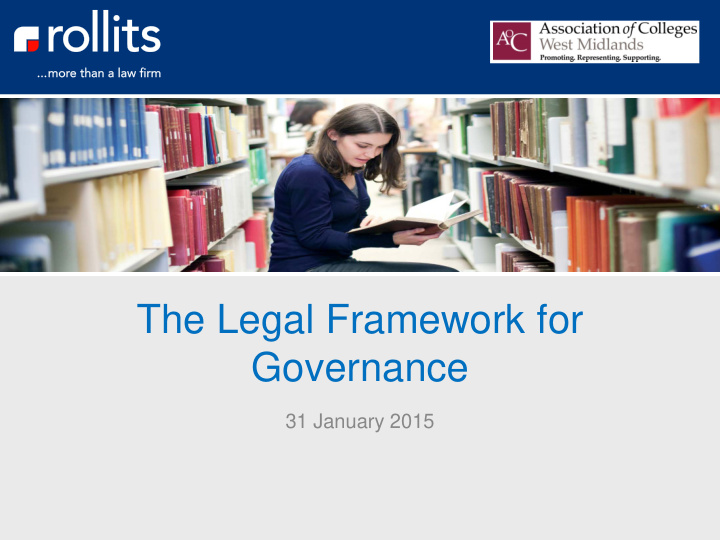



The Legal Framework for Governance 31 January 2015
Tom Morrison INTRODUCTIONS
Gerry Morrison & Tom Morrison LEGAL STRUCTURES AND EDUCATION PROVIDERS
Legal Structures for Further Education Providers • Statutory Further Education Corporations • Education Act 2011 • Companies • Charitable Status • Subsidiaries - wholly owned subsidiaries - joint venture companies • Relationship between Further Education Corporations and Subsidiaries • Academy Trusts
Statutory Further Education Corporations • Majority of Further Education Colleges • Set up by order of the Secretary of State under the FHEA • Powers vested by Act of Parliament • Independent Corporate Bodies • Own legal personality distinct from governors/members • Instruments and Articles of Government • Purposes set out in Section 18 and 19 FHEA • Composition, procedures, internal powers • Private training providers = mainly companies • A few colleges are companies
Education Act 2011 • Prior to EA 2011 Further Education Corporations’ instruments and articles could only be amended by regulations made by SOS under FHEA • Amending regulations issued periodically, uncommon for FE Corporations to request bespoke changes • Less flexible, hard to change governance structures, internal procedures • FE Corporations at a disadvantage to private training providers and colleges established as companies
Post-Education Act 2011 • FE Corporations’ freedom to amend instruments and articles • Instruments and articles must specify how FE Corporation may amend them • SOS power to amend, replace or revoke • Change composition of governing body, procedures and internal powers • Balance flexibility, efficiency with protecting the organisation’s aims, assets and beneficiaries • Remove some of the previous disadvantages • Provided instruments and articles comply with Schedule 4 of FHEA (minimum requirements for governance)
Post-Education Act 2011 • FE Corporations’ power to dissolve themselves • FE Corporations may transfer property, rights and liabilities upon dissolution to specified education providers for educational purposes • Consultation required • FE Corporations can use EA 2011 powers to convert legal structure • Rationale for change?
Companies • Limited by shares • Limited by guarantee • Regulated and incorporated by Companies House • Companies Act 2006 • Memorandum and Articles • Power to amend articles and dissolve • Two-tier system of governance - directors and members • Statutory directors’ duties
Powers • Power for FE Corporations to convert legal structures to companies • Can be a wholly-owned subsidiary of Further Education Corporation or joint venture companies • Academy Trusts
Charitable Status • FE Corporations are exempt charities • Principal Regulator SOS for Department for Business Innovation and Skills • FE Corporations cannot amend instruments and articles to cease being charities • Governors’ legal duties and responsibilities as charity trustees • The Charity Commission, The Essential Trustee: What you need to know • Aims for public benefit
Advantages Charitable Status • Tax breaks • FE Corporations exempt from corporation tax, income and capital gains taxes arising out of the provision of education and stamp duties • Fundraising • PR benefits • Asset-lock
Disadvantages Charitable Status • Perceived red tape (charity law) • Complex rules trading activities • FE Corporations cannot carry out large scale non- charitable trading or non-primary purpose trading • Routed through subsidiary • Ultra vires, breach charity law, tax penalties • Rules on payment of governors as charity trustees • Partnership/joint ventures with non-charities additional red tape
Tom Morrison & Gerry Morrison SUBSIDIARIES, JOINT VENTURES AND COLLABORATION IN THE EDUCATION SECTOR
Subsidiaries • Wholly-Owned Subsidiaries – colleges can establish separate legal entities to run different activities across their group – ring-fences risks/liabilities – commonly create wholly-owned subsidiary companies – tax efficient gifting of surplus to parent college – diversification of activities – development of new brands – acquire private training providers
Relationship between Further Education Providers and Subsidiaries • Non-charitable subsidiary - arm’s length commercial relationship between subsidiary and parent charity • Subsidiary = separate legal entity with its own legal personality • Directors of subsidiaries not all the same as college governors • Conflicts of interest • Charity law regulates funding of subsidiaries by FE Corporations • Reporting/Monitoring
When might a subsidiary be appropriate and what are the alternatives?
Legal models for collaboration • Wide ranging • No single definition • Interchangeable use of terms • Joint venture = JV • Legal entity (Specific Purpose Vehicle = SPV) • Partnership • Contractual joint venture • Collaboration or subcontracting?
Joint Venture Companies • Partnerships/joint ventures between FE Corporations and non-charities/other organisations/colleges • Ring-fences risk/liabilities • Apprenticeship training agencies • Owned by the College and one or more third parties • Membership Agreement
Rationale • Key to any successful collaboration • Short term requirement? • Longer term benefits? • Driven by specific project requirements? • Political drivers? • Cost saving? • Creating capacity? • Better together? • Rationale should dictate choice of legal model
Distinct projects • Large scale projects • Bringing together multiple partners • Geographic reach • Capability • Capital projects - more likely to be SPV • Revenue projects - more likely to be contractual JV
Longer term requirements • Collaborative working for the long term • Explored other options - e.g. merger? • Typically transfer of functions into a SPV • Outsourcing • Procurement • Governance of the SPV • Longer term contractual alternatives
Academy Trusts • Companies limited by guarantee • Exempt charities • Sponsored by Colleges • Set up multi-academy trusts • Independent, separate legal entities, own legal personality • Funded directly by Department for Education via a funding agreement • Relationship with the college as sponsor • Conflicts of interest
Group discussion and questions
Tom Morrison Gerry Morrison Partner Partner tom.morrison@rollits.com gerry.morrison@rollits.com 01482 337310 01482 323239 01904 625790 01904 688539
Recommend
More recommend